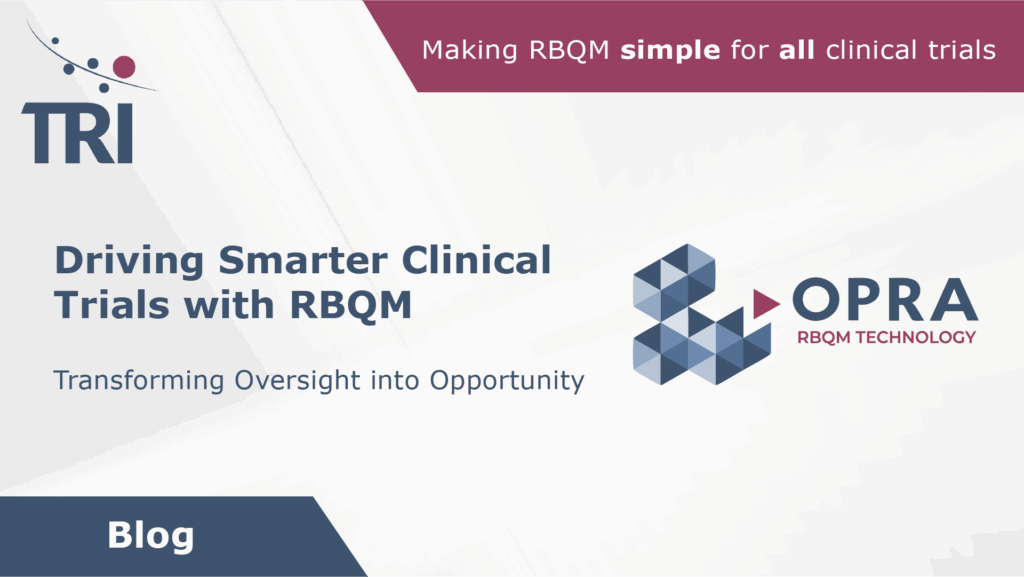Driving Smarter Clinical Trials with RBQM

RBQM as a Catalyst for Smarter Clinical Trials
Clinical trials are evolving rapidly.
According to Tufts Center for the Study of Drug Development, protocol complexity has increased by over 60% in the past decade.
If you were designing a clinical trial today, would you build it the same way you did five years ago?
Of course not. The world has changed. The data has changed. The expectations have changed. And now, with the release of ICH E6(R3), the rules have finally caught up.
It’s a challenge to rethink how we approach quality, oversight, and risk. And if we’re serious about answering that call, Risk-Based Quality Management (RBQM) is essential.
Delivering the Vision of ICH E6 (R3)
For years, we’ve been working within a framework built for a different era. One-size-fits-all monitoring.
E6(R3) changes that. It tells us: focus on what matters. Design for quality. Monitor with intelligence. And above all, be proportionate.
This is the strategic clarity the industry has long awaited. And it’s exactly what RBQM was built to support.
RBQM: From Theory to Transformation
RBQM is a strategic shift.
It means identifying what’s critical to quality. It means assessing risk continuously. It means using data not just to report, but to predict.
And it means empowering teams to act, not react.
ICH E6 (R3) introduces a way to oversee clinical trials, focusing on smart strategy instead of rigid procedures. Risk-Based Quality Management (RBQM) is the mechanism that brings this framework to life.
- Quality-by-Design is now foundational. RBQM enables teams to identify critical-to-quality (CtQ) factors during protocol development, ensuring that trial design is focused, and aligned with outcomes that matter.
- Risk-Proportionality shifts the emphasis to intelligent prioritization. With RBQM, resources are directed toward areas of highest impact, enhancing efficiency without compromising integrity.
- Data Reliability is the new benchmark. RBQM ensures that data collected throughout the trial is not only accurate, but consistently supports sound decision-making and regulatory confidence.
It’s the evolution of clinical trial strategy, where quality is intentional and data drives meaningful action.
OPRA: The Platform That Makes It Possible
At TRI, we built OPRA to be a catalyst.
OPRA is our RBQM platform, designed to turn the principles of E6 (R3) into daily practice.
OPRA-CM (Central Monitoring) gives you real-time visibility into trial health. Think of it as a control tower for your study, spotting turbulence before it disrupts the flight.
OPRA-RAM (Risk Assessment & Management) is where your risk strategy lives. It’s where CtQ factors are tracked, mitigation plans are managed, and oversight becomes transparent.
Together, they help teams move from reactive firefighting to proactive leadership.
Turning Complexity into Clarity
Clinical trials today are more complex than ever. Traditional monitoring methods, while familiar, often struggle to keep pace with this complexity. That’s where Risk-Based Quality Management (RBQM) proves its value.
Centralized monitoring, a key part of RBQM and OPRA, helps spot real-world risks and data issues earlier. According to the FDA’s guidance on risk-based monitoring, centralized approaches can improve data quality and trial efficiency by identifying issues faster and more accurately than routine site visits alone.
RBQM also supports smarter resource allocation. By focusing on critical-to-quality (CtQ) factors, teams can reduce unnecessary monitoring burden, streamline workflows, and maintain oversight where it matters most. This leads to better decision-making, stronger compliance, and ultimately, more resilient trials.
In short, RBQM transforms complexity into clarity, and OPRA makes that transformation scalable and repeatable.
OPRA and Cross-Functional Collaboration
Clinical trials don’t succeed in silos. They require coordination across multi-disciplinary teams.
OPRA was built to support that collaboration.
It provides a shared language for risk. A unified platform for action. When everyone can see the same data, understand the same risks, and contribute to the same solutions. This creates something powerful: alignment.
And alignment is what turns good trials into great ones.
Why This Moment Matters
We’re facing urgency.
Budgets are tightening. Timelines are compressing. Protocols are more complex. And the pressure to deliver faster, more reliable results has never been greater.
Regulators are evolving. Patients are expecting more. The old ways of working? They’re simply not sustainable anymore.
ICH E6(R3) directly responds to this reality. It gives us a framework to adapt and prioritize. But a framework is only as powerful as the system that supports it.
That system is RBQM: the infrastructure designed for modern trial oversight.
It’s how we move from reactive to proactive, and from compliance-driven to quality-led.
The organizations that embed RBQM into their operations are building the infrastructure for smarter and more resilient trials.
Now is the time to lead.
The Leadership Imperative
ICH E6(R3) redefines what leadership demands in clinical research: accountability, and strategic intent.
This is the moment to lead with purpose.
RBQM is the mechanism that makes it possible: enabling the shift from reactive oversight to proactive control, and from baseline compliance to embedded, measurable quality.
So here’s the challenge to every stakeholder in clinical research:
- Move beyond compliance, aim for excellence.
- Shift from reacting to problems to designing for prevention.
- Break down silos and build systems that connect and inform.
At TRI, we’re at the forefront of driving innovation.
RBQM is already shaping how the most effective teams run trials today. It’s the shift from reacting to building quality into every decision.
Let’s stop designing for yesterday’s challenges and start building for tomorrow’s standards.
The future of clinical research will be shaped by those who take control of risk, and OPRA is how we lead that change.
